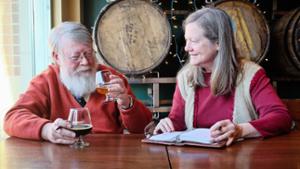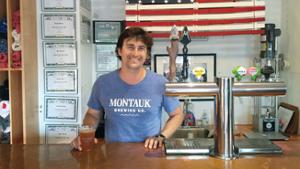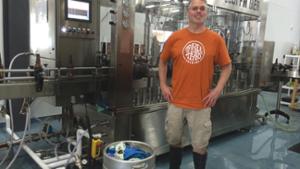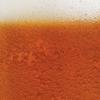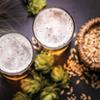
Entrebrewneurs
“The first beer I brewed was a spruce beer in 1993. My boyfriend and I — actually, Robert McMinn ’88 — went to visit his dad in Binghamton [N.Y.] and harvested spruce branches from his yard. As I recall, it turned out quite well, especially for a first brew. Definitely drinkable and different,” says Gwen Sanchirico ’89, who still has her brew log from those amateur days. She founded and runs a microbrewery in Wolverhampton, England.
For Eric Feldman ’03 it was an English brown ale. After he and his buddy spent $200 on a home-brew kit, he took a day off from his job as an attorney to hole up and concoct his first beer. The brown ale, a success, proved to be a gateway brew: Feldman and his friend kept at home brewing past the point of no return. From designing the recipe to applying the science, the process captivated Feldman. The day came when he quit his career as a lawyer to co-found Braven Brewery. It produced its first batch of beer in December 2014, brewing 2,130 barrels the first year.
Feldman can expound on the history of beer in Brooklyn, future site of Braven’s own brewery. At the moment, Braven has its beer made at a brewery in Saratoga Springs, N.Y., an arrangement known as contract brewing, but is working toward opening its own facility. A few years into his new vocation, Feldman remains fascinated by brewing the way he never was by a lawyer’s life.
“There’s so much history to where styles come from and why things are the way they are. All these taxonomies, new vocabulary. And to me, it opened up this whole world of new and exciting learning that I would actually want to be a part of,” he says.
He and Sanchirico are among several Hamilton grads who brew beer as a profession. All of them were inspired by a love for good beer and their success as home brewers. To anyone with a taste for beer, to talk to the Hamilton microbrewers about their work — the white India pale ale, the black pale ale, the summer ale, the English-style bitter — is to long for the clock to strike happy hour.
Besides the brewers, there’s a Hamilton-Kirkland partnership that occupies its own niche in the expanding universe of craft beers. Bob and Ellie Spencer Tupper, of Bethesda, Md., are connoisseurs who have spent decades tasting and evaluating beer. Bob, a government major, graduated in 1969, and Ellie, a literature and writing major, is a 1972 Kirkland alumna. They married while she was still a student. As fate would have it, their love affair with beer and one another coincided with the fall and rise of independent breweries in the U.S. They were scouting out obscure breweries years ahead of the craft-beer trend. They witnessed the independent brewing renaissance that now includes the more recent Hamilton alumni.
“D.C.’s Original Beer Geeks”
Bob is a high school teacher who works part time, and Ellie is a production editor with ASM Press, the book-publishing arm of the American Society for Microbiology. They are not home brewers. They haven’t forgotten the mouth-puckering disaster of their first and only home brew, which was meant to be an ale but tasted like vinegar. “It was an epiphany,” Bob says. “The Lord spoke to me, and he said, ‘Tupper, we hope you understand that there are those who make the beer and those who taste and evaluate the beer. We also hope you realize which group you are in.’”
For decades they’ve traveled Europe and the U.S. tasting and taking notes on beer, building a database of more than 29,000 entries. Bob has been hosting beer tastings and lectures for more than 30 years. A 2014 story in Washington City Paper dubbed them “DC’s original beer geeks.” They turned their 30 years of travel stories and knowledge into a book published in 2015, Drinking In the Culture, a sort of beer travel guide that explores great beers and the history and culture surrounding them.
In the mid 1990s the couple came up with a concept for a beer based on what they learned tasting and chatting up brew masters. They pitched their idea to Old Dominion Brewing Co. (now defunct) in Ashburn, Va., for an ale that was treated like a lager. They would use an American yeast strain and ferment and condition the ale to give it smoothness. The Tuppers would pay for some expenses, Dominion would make the beer, and they’d split the profits, should there be any.
The Tuppers also made a deal with themselves. They view money from their “beer thing” as a gift, and they decided that in the unlikely event that Tuppers’ Hop Pocket Ale made any profit, they would put half in a college account for their daughter, Laurie, and donate the other half to charities. Hop Pocket arrived in 1994 or 1995, and the digital word spread among beer geeks. The ale became a cult favorite, Ellie says. It also won the prestigious gold medal in the American pale ale category at the 1997 Great American Beer Festival and garnered other kudos and great reviews.
The Tuppers and Old Dominion followed up with Tuckers’ Keller Pils, also an award-winning success. The two beers, which are no longer in production, made enough money to pay for seven semesters at Swarthmore and benefit several charities.
In their early pursuit of good beer, the couple felt a sense of urgency to taste as many different kinds as they could. The giant national breweries were ascending, and the little operators were going down. The Tuppers thought independent breweries were disappearing forever. “At the time we were chasing beers all over the U.S., mostly to try to get to them before they closed. And we visited dozens of breweries that closed within two years of our visit. We were witnessing the death of an industry,” Bob says.
They never imagined they’d see it revive. These days, if there is cause for urgency in beer tasting, it is for a happier reason: so many beers, so little time. “We know that we’re not going to be able to keep up with all of them. But we’ll give it the college try,” Ellie says.
Between 1994 and 2015, the number of U.S. microbreweries grew from 192 to 2,397, according to the American Brewers’ Association. The number of brewpubs and regional breweries has skyrocketed as well. Joseph Sullivan ’07 joined the ranks in 2012, founding Montauk Brewing Co. with two longtime friends.
Business and pleasure
Sullivan, who was an economics major, decided his sophomore year at Hamilton that he wanted to have a brewery someday. In 2008, living in Montauk, N.Y., near his home turf of East Hampton, he and two friends made their first joint-venture home brew, an India pale ale, usually referred to as IPA. “It turned out great — luckily,” Sullivan says. The beginning brewers at first kept their day jobs at a solar panel company but brewed every weekend and threw parties to test their recipes on willing friends.

It took three years of planning, tweaking recipes and securing financing to launch Montauk. It’s located in a barn that was once a woodworking shop that belonged to a partner’s father. At first, Montauk contracted out its brewing, but in July 2015 started production at its own brewery and expects to make 15,000 barrels this year. Hamiltonians wander into the tasting room on a regular basis. “Which is the coolest thing,” says Sullivan, who will buy them a beer. Feldman has been in twice, with a purpose.
When he was still planning for his operation, he learned of Sullivan’s brewery and sought him out for advice. They picked one another’s brains. “Everything in the craft world, at least still today, we’re all close,” Sullivan says. “We are direct competitors, but it’s still all of us against the Budweisers, Millers, Coors, Coronas. We know that we have to stay together in order to take whatever we can from the big guys.”
Another Hamilton-connected little guy, Three Heads Brewing in Rochester, N.Y., started contract brewing at the end of 2010 and in July opened its own brewery with the capacity to turn out about 15,000 barrels a year. Co-founder Dan Nothnagle ’91, who was a philosophy major, also got his start home brewing with friends who would become his partners. Their first home brew was a terrible IPA but they caught on quickly. “We started winning awards in local and regional home-brew contests within the first three to six months. I’m sort of a passionate individual,” Nothnagle says.
Labor of love
Nothnagle’s work at Three Heads is hands on, six days a week and sometimes seven. Don’t look for him at his desk, dreaming up recipes. “I’m bleeding kegs, bottling beers, all that kind of stuff,” he says. But that’s OK. Before he was a brewer, Nothnagle was the marketing director for a good-sized regional real estate firm, his family’s business. “I went back to where I used to work up until about three years ago, and it really felt like death there. So it’s truly exciting doing something that you really want to do,” he says.

At Sacre Brew, Sanchirico relies on people who share the love. “The brewery has been run so far purely by volunteers — that includes me. I get help from people who not only love beer but who are enthusiastic about what I’m trying to do with Sacre Brew, and they want to be part of it,” she says. Sacre Brew started brewing regularly in October 2014. It’s small even by microbrewery standards, producing, on average, one 200-liter batch a week, which equals roughly 550, 12-ounce bottles.
Before she became a professional brewer, Sanchirico, a linguistics major, was a project manager for a software development team at Mount Sinai Hospital in New York City. Then she met and married a man from Wolverhampton, where they now live. At that point she was a veteran home brewer but wasn’t doing much of it. After her move abroad she got going again. Sanchirico is less than keen on the quality of English beer. “To me, most English beer tastes like the water left overnight in a pot of boiled beans: bland and flat with a squirt of soap,” she says.
No two palates are identical. The Tuppers are English beer fans who have tasted more than 4,000 different beers brewed in the United Kingdom. Five of the 24 “great beer cities” they name in their book are in the U.K. Some day Sanchirico and the Tuppers may have a chance to share a pint and trade opinions. The Tuppers still spend time tasting in Europe and are working on a new book about where to find good beer in unexpected places, for instance, Rome, three blocks from the Colosseum. If he can do it, Bob would like to visit all the breweries in the Hamilton family.
“Ten years ago I would have assured you we would because we got to the majority of breweries in the country — visiting breweries in 46 states before we began to really focus on Europe. Now we haven’t even been to all the breweries in our neighboring county,” he says.
Feldman is interested to see how the market handles all the craft-brewing options over the next few years. He is convinced that once people acquire a taste for craft beer, they won’t go back. Whatever happens, he’s glad he started Braven.
“This was the change that I wanted for my life. And I think whatever happens from here, if Braven is a 50-year project and it becomes a family business, I’ll be thrilled. And I can’t wait to see that possibly happen,” he says. “If we get acquired or something else happens, and this isn’t a forever project, it’s taught me more about business, it’s taught me more about how I operate, it’s put me more in the driver’s seat, than anything I’ve ever done before.”
A Brief Guide to Beer Styles
Lagers
Kölsch: Remarkably delicate golden ales, most American “Kolsch” beers bear little resemblance to the original but are more similar to strong UK gold ales. Alt Beers, from nearby Düsseldorf, are similar but much darker and a bit heavier.
British Gold Ales are gently hopped, fairly sweet and golden. Can be quite floral.
Pilsners, such as Pilsner Urquel, are golden in color and clean and crisp, with a bit of a cleansing bite at the end.
Helles Lager, such as Spaten or Hofbrau Lager, is similar to a pilsner, though sweeter and slightly lower in alcohol.
American Lagers such as Yuengling are amber in color and sweet from the use of caramel syrups. Dunkel Beers are dark in color and usually sweet on the palate.
Bock Beers are dark or light, strong, sweet lagers (near 7% abv). Doppelbock Beers are usually dark and stronger, with German brewers topping out at about 8% and Americans sometimes hovering near 10%. The original was Paulaner’s Salvator, brewed by monks to sustain themselves during Lent, so now most Doppelbocks borrow the suffix and end in “ator.”
Ales
British Pale Ales, or Bitters, are usually low in alcohol (4% or less) but have perceptible hops that often smell or taste of flowers.
American Pale Ales (APA), such as Sierra Nevada Pale Ale, can be rich gold to dark amber and have a significant hop finish. Hops add bitterness and can create flavors such as citrus, stone and tropical fruits, spices and herbs, fresh or dry grass, mint, earth and pine.
IPAs, India Pale Ales, were brewed to withstand the brutal sea voyage from England to India by increased alcohol and hop rates. They range from about 6% to just short of 8% abv. The hop range is similar to APAs but much more intense. Double IPAs are even more extreme, with pronounced fruits and bitterness and alcohol that can approach 10%.
Barley Wines can be very similar to Double IPAs, but are sometimes darker and even stronger. Hops can range from “enough to balance” to “enough to glue your lips shut.”
Wheat Ales
German style Hefeweizen beers are low in bitterness and characterized by clove, pepper, banana and even bubble gum esters produced by the distinctive yeast.
Belgian Wit beers are unfiltered, chalky and lemony. Spiced with coriander and orange peel, they’re perfect on a summer’s day. Blue Moon is a distant descendant.
Note: Wheat beers in Europe are almost never served with fruit.
Wild & Sour Ales
The Flanders Red Ales are traditional sour ales such as Rodenbach, fermented with a complex blend of yeasts, bacteria and enzymes. A handful of the hundreds of new breweries experimenting with barrel aging approach Rodenbach’s sophistication.
Wild Ales include traditional Belgian lambic beers, fermented spontaneously. In the hands of skilled gueuze blenders such as Cantillon and Boon, the sharp acidic flavors are balanced by a complexity that can only come from years of conditioning.
For Serious Scholars Only
In July, the Smithsonian’s National Museum of American History posted a job for a beer historian. Social media lit up with the news that $64,650 (plus benefits) would be offered to the right candidate — though many commented it’s a job they’d pay to have.
To offer background on the position, Aaron Sprengeler wrote a piece for CraftBeer.com. What follows is an excerpt:
A few months ago, at the Craft Brewers Conference, the National Museum of American History announced a new initiative that would expand its ongoing Smithsonian Food Project to include brewing in America. Through support from the Brewers Association, the three-year initiative will be used to “collect, document and preserve the history of brewing, craft brewers and the beer industry.” This initiative serves as an opportunity to explore how beer and brewing connect to larger themes in American history.
“Brewing has a long and deep connection to our country’s history, and the museum’s collections explore the history of beer from the late 19th to early 20th centuries,” said John Gray, the director of the museum.
But a lot has happened in American brewing in the last two decades — the number of operating breweries in the U.S. has hit an all-time high of 4,656 — and the initiative will help tell that story.
One of the most exciting things to come from this initiative so far is the viral response to the Smithsonian’s search for a beer historian. Let’s be clear: This is not a beer-tasting position. They are looking for a trained historian to conduct archival and field research on the long history of brewing in America, including the craft industry, to acquire objects for the museum’s collections. Whoever gets the job will go beyond what’s in the glass and also explore connections to business, innovation, immigration, food, agriculture, cultural and community history and document brewing as a part of the larger narrative of American history.
